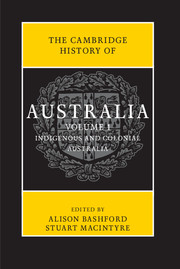Book contents
- Frontmatter
- Contents
- Abbreviations
- List of maps
- List of figures
- List of tables
- Notes on contributors
- Map
- Preface
- Introduction
- PART I
- PART II
- 11 Environmental transformations
- 12 Population and health
- 13 The economy
- 14 Indigenous and settler relations
- 15 Education
- 16 Law and regulation
- 17 Religion
- 18 Colonial science and technology
- 19 Gender and colonial society
- 20 Art and literature: a cosmopolitan culture
- 21 Empire: Australia and ‘Greater Britain’, 1788–1901
- 22 Colonial Australia and the Asia-Pacific region
- 23 The Australian colonies in a maritime world
- Further reading
- Chronology
- Index
- Frontmatter
- Contents
- Abbreviations
- List of maps
- List of figures
- List of tables
- Notes on contributors
- Map
- Preface
- Introduction
- PART I
- PART II
- Further reading
- Chronology
- Index
23 - The Australian colonies in a maritime world
from PART II
Published online by Cambridge University Press: 05 November 2013
- Frontmatter
- Contents
- Abbreviations
- List of maps
- List of figures
- List of tables
- Notes on contributors
- Map
- Preface
- Introduction
- PART I
- PART II
- 11 Environmental transformations
- 12 Population and health
- 13 The economy
- 14 Indigenous and settler relations
- 15 Education
- 16 Law and regulation
- 17 Religion
- 18 Colonial science and technology
- 19 Gender and colonial society
- 20 Art and literature: a cosmopolitan culture
- 21 Empire: Australia and ‘Greater Britain’, 1788–1901
- 22 Colonial Australia and the Asia-Pacific region
- 23 The Australian colonies in a maritime world
- Further reading
- Chronology
- Index
- Frontmatter
- Contents
- Abbreviations
- List of maps
- List of figures
- List of tables
- Notes on contributors
- Map
- Preface
- Introduction
- PART I
- PART II
- Further reading
- Chronology
- Index
Summary
Assumptions about an impermeable maritime frontier remain enshrined in what is arguably the most famous (and most mocked) line of ‘Advance Australia Fair’, composed in 1878:‘Our home is girt by sea’. As the national anthem since 1984, the song reminds us that Australia is an island continent, the only nation-state to have a major landmass to itself. Yet across the eighteenth and nineteenth centuries the oceans enabled connection as well as separation. Colonial Australia emerged as a society that was bound within developing global networks, connected through the movement of individuals, geostrategic naval decisions, flows of information and trade routes. Such networks, particularly in the north of the continent, created distinct communities that locked Australia into its immediate maritime region. In the period during which the Australian colonies came into being, it was the maritime that structured, enabled and set the terms by which networks of global connection were forged, sustained and broken.
Trade and shipping
Maritime connections between Australia and the wider world long pre-dated the arrival of Europeans on the continent. Voyagers from what would become the Indonesian archipelago crossed the Timor Sea to develop a centuries-long association with the Indigenous people of northern Australia, primarily through the trepang industry that harvested marine invertebrates for consumption in Asian markets. The north-western edge of the continent was bound into established regional networks; in terms of geography, culture and commerce, this coast of Australia could perhaps be more accurately envisaged as the furthest shoreline of Southeast Asia.
So, too, Australia's west coast was known to Europeans long before its east coast. The Dutch route to the East Indies took ships up the west coast, and prevailing winds, currents and navigational limitations drove many ashore. Yet the apparently inhospitable landscape discouraged further investigation. Well over a century later, in 1770, armed with superior navigational instruments and new scientific curiosity about the landscape's potential, Lieutenant James Cook managed to land on Australia's east coast. With Cook's arrival, Australia was drawn into Britain's imperial network and assessed according to its strategic objectives.
- Type
- Chapter
- Information
- The Cambridge History of Australia , pp. 560 - 584Publisher: Cambridge University PressPrint publication year: 2013
- 3
- Cited by



